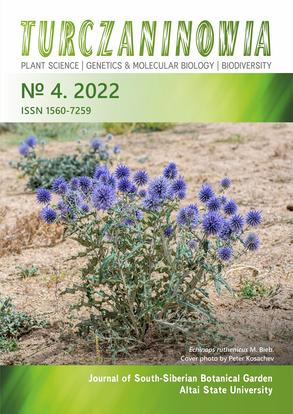Asplenium delinghaense, a new species from western part of Qilian Mountains in Qinghai-Xizang Plateau
Abstract
A new species of the genus Asplenium L. from northern Qinghai, A. delinghaense S. Q. Liang et X. C. Zhang, is described and illustrated here. This new species resembles A. iskardense Viane et Reichst., A. daghestanicum Christ, and A. neovarians Ching but differs in frond and perispore morphology. Molecular phylogenetic evidence supported the close relationship of A. delinghaense with members of the A. varians complex and the A. pekinense complex and indicated an allotetraploid origin of it.
Downloads
Metrics
References
Díez C. M., Gaut B. S., Meca E., Scheinvar E., Montes‐Hernandez S., Eguiarte L. E., Tenaillon M. I. 2013. Genome size variation in wild and cultivated maize along altitudinal gradients. New Phytologist 199: 264–276. DOI: 10.1111/nph.12247
Kramer K. U., Viane R. 1990. Aspleniaceae. In: K. U. Kramer, P. S. Green (eds.). The families and genera of vascular plants. Vol. 1. Pteridophytes and gymnosperms. Berlin: Springer. Pp. 52–57.
Liang S.-Q., Viane R. L. L., Zhang X.-C., Wei R. 2021. Exploring the reticulate evolution in the Asplenium pekinense complex and the A. varians complex (Aspleniaceae). Journal of Systematics and Evolution 59(1): 125–140. DOI: 10.1111/jse.12530
Liang S.-Q., Zhang X.-C., Wei R. 2019. Integrative taxonomy resolved species delimitation in a fern complex: A case study of the Asplenium coenobiale complex. Biodiversity Science 27(11): 1205–1220. [In Chinese]. DOI: 10.17520/biods.2019316
Lin Y.-X., Viane R. 2013. Aspleniaceae. In: Z.-Y. Wu, P. H. Raven, D.-Y. Hong (eds.). Flora of China. Vol. 2–3. Beijing: Science Press; St. Louis: Missouri Botanical Garden Press. Pp. 267–316.
Mei L.-J. 1997. Aspleniaceae. In: L.-H. Zhou, R.-F. Huang (eds.). Flora Qinghaiica, Vol. 1. Xining: Qinghai People’s Publishing House. Pp. 23–25. [In Chinese]
Moscone E. A., Baranyi M., Ebert I., Greilhuber J., Ehrendorfer F., Hunziker A. T. 2003. Analysis of nuclear DNA content in Capsicum (Solanaceae) by flow cytometry and Feulgen densitometry. Annals of Botany 92: 21–29.
Nguyen L.-T., Schmidt H. A., von Haeseler A., Minh B. Q. 2015. IQ-TREE: A fast and effective stochastic algorithm for estimating maximum likelihood phylogenies. Molecular Biology and Evolution 32(1):268–274. DOI: 10.1093/molbev/msu300
Rothfels C. J., Sundue M. A., Kuo L.-Y., Larsson A., Kato M., Schuettpelz E., Pryer K. M. 2012. A revised family-level classification for eupolypod II ferns (Polypodiidae: Polypodiales). Taxon 61(3): 515–533. DOI: 10.1002/tax.613003
Schneider H., Russell S. J., Cox C. J., Bakker F., Henderson S., Rumsey F., Barrett J., Gibby M., Vogel J. C. 2004. Chloroplast phylogeny of asplenioid ferns based on rbcL and trnL-F spacer sequences (Polypodiidae, Aspleniaceae) and its implications for biogeography. Systematic Botany 29(2): 260–274. DOI: 10.1600/036364404774195476
Sleep A., Reichstein T. 1984. Typification of Asplenium varians Wall. ex Hook. et Grev. (Aspleniaceae, Pteridophyta). Studies in Asplenium for “Flora Iranica”: 5. Candollea 39(2): 675–691.
Viane R. L. L. 1987. Notes about Asplenium I. Asplenium quezelii, a pseudo-endemic species identical with A. daghestanicum (Aspleniaceae: Pterisophyta). Fern Gazette 13(3): 143–149.
Viane R. L. L., Reichstein T. 2003. Notes on new or interesting Asplenium species from western Asia, including comments on Ching and Wu (1985), and Fraser‐Jenkins (1992) Reliquiae Reichsteinianae 1. In: S. Chandra, M. Srivastava (eds.). Pteridology in the new millennium. Netherlands: Springer. Pp. 73–105.
Wu S.-H. 1999. Aspleniaceae. In: S. H. Wu (ed.). Flora Reipublicae Popularis Sinicae. Vol. 4(2). Beijing: Science Press. Pp. 1–153. [In Chinese]
Turczaninowia is a golden publisher, as we allow self-archiving, but most importantly we are fully transparent about your rights.
Authors may present and discuss their findings ahead of publication: at biological or scientific conferences, on preprint servers, in public databases, and in blogs, wikis, tweets, and other informal communication channels.
Turczaninowia allows authors to deposit manuscripts (currently under review or those for intended submission to Turczaninowia) in non-commercial, pre-print servers such as ArXiv.
Authors who publish with this journal agree to the following terms:
- Authors retain copyright and grant the journal right of first publication with the work simultaneously licensed under a Creative Commons Attribution License that allows others to share the work with an acknowledgement of the work's authorship and initial publication in this journal.
- Authors are able to enter into separate, additional contractual arrangements for the non-exclusive distribution of the journal's published version of the work (e.g., post it to an institutional repository or publish it in a book), with an acknowledgement of its initial publication in this journal.
- Authors are permitted and encouraged to post their work online (e.g., in institutional repositories or on their website) prior to and during the submission process, as it can lead to productive exchanges, as well as earlier and greater citation of published work (See The Effect of Open Access).









